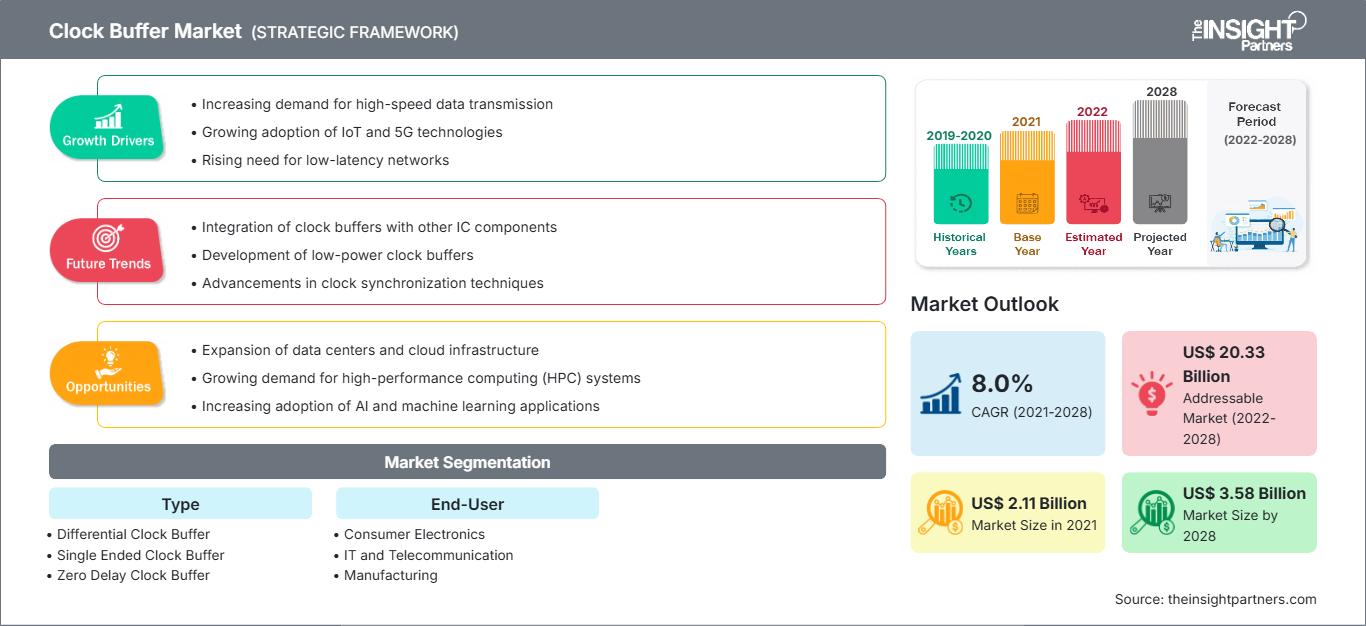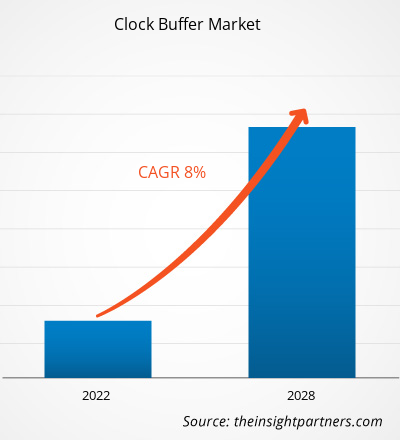Der Markt für Taktpuffer soll von 2.112,53 Millionen US-Dollar im Jahr 2021 auf 3.579,91 Millionen US-Dollar im Jahr 2028 anwachsen; von 2022 bis 2028 wird ein CAGR-Wachstum von 8,0 % erwartet.
Der globale Markt für Taktpuffer ist geografisch in Nordamerika, Europa, Asien-Pazifik, Naher Osten und Afrika sowie Südamerika unterteilt. Im Jahr 2021 führte Nordamerika die Marktanalyse für Taktpuffer mit einem Anteil von 40,5 % an, gefolgt von Asien-Pazifik und Europa. In den letzten Jahren ist die Nachfrage nach Cloud Computing stark gewachsen, was zu einer verstärkten Verbreitung des Internets geführt hat. Daher investieren viele ausländische Direktinvestitionen massiv in Nordamerika, was sich positiv auf das Cloud Computing auswirkt. Die US-Regierung hat zahlreiche Initiativen ergriffen, um die Unterhaltungselektronikbranche anzukurbeln. So legte die US-Regierung am 6. Mai 2022 einen neuen parteiübergreifenden Gesetzesentwurf zur Förderung des Leiterplattensektors vor. Viele etablierte Unternehmen der US-amerikanischen Elektronikfertigungsbranche begrüßten den Vorschlag. Der Gesetzentwurf unterstützt den CHIPS Act von 2021 und den American Printed Circuit Boards Act von 2022. Dadurch ergeben sich für die wichtigsten Akteure auf dem nordamerikanischen Markt für Taktpuffer in den kommenden Jahren lukrative Geschäftsmöglichkeiten. Der Markt für Taktpuffer im asiatisch-pazifischen Raum ist in Indien, China, Japan, Australien und den Rest des asiatisch-pazifischen Raums segmentiert. Viele Regierungen in der Region waren aufgrund der COVID-19-Krise gezwungen, ihre Vorgehensweise beim Kauf modernisierter Geräte wie Desktops, Laptops und PCs sowie allgemeiner Serverausrüstung von ausgewählten Lieferanten und Herstellern zu überdenken. Daher steigt die Nachfrage nach anderen Kommunikationssystemen wie Routern, Modems, drahtgebundenen und drahtlosen Elektroniksystemen (Panels) und anderen Peripheriegeräten, was viele lukrative Geschäftsmöglichkeiten für die wichtigsten Anbieter im Markt für Taktpuffer geschaffen hat. In Indien haben Anbieter von Informations-, Kommunikations- und Technologiediensten und -lösungen aufgrund der COVID-19-Krise ihre Geschäftsmodelle auf Remote-Arbeit umgestellt. Schulen und Hochschulen arbeiteten auch 2022 weiterhin aus der Ferne, sodass Studierende dringend ein Computergerät benötigten. Einige Studierende, die zuvor Smartphones/Tablets für den virtuellen Unterricht nutzten, sind auf PCs umgestiegen, da diese Vorteile wie größere Bildschirme und eine höhere Benutzerfreundlichkeit bieten, was sich positiv auf den Markt für Taktpuffer auswirkt.
Passen Sie diesen Bericht Ihren Anforderungen an
Sie erhalten kostenlos Anpassungen an jedem Bericht, einschließlich Teilen dieses Berichts oder einer Analyse auf Länderebene, eines Excel-Datenpakets sowie tolle Angebote und Rabatte für Start-ups und Universitäten.
Markt für Taktpuffer: Strategische Einblicke

- Holen Sie sich die wichtigsten Markttrends aus diesem Bericht.Dieses KOSTENLOSE Beispiel umfasst Datenanalysen, die von Markttrends bis hin zu Schätzungen und Prognosen reichen.
Sie erhalten kostenlos Anpassungen an jedem Bericht, einschließlich Teilen dieses Berichts oder einer Analyse auf Länderebene, eines Excel-Datenpakets sowie tolle Angebote und Rabatte für Start-ups und Universitäten.
Markt für Taktpuffer: Strategische Einblicke

- Holen Sie sich die wichtigsten Markttrends aus diesem Bericht.Dieses KOSTENLOSE Beispiel umfasst Datenanalysen, die von Markttrends bis hin zu Schätzungen und Prognosen reichen.
Auswirkungen der COVID-19-Pandemie auf den Markt für Taktpuffer
Dank der günstigen Regierungspolitik zur Förderung von Innovationen und zur Stärkung der Infrastrukturkapazitäten weist Nordamerika die höchste Akzeptanz und Entwicklungsrate neuer Technologien auf. Laut CBREs North American Data Center Trends Report 2020 war der Rechenzentrumssektor der Region im ersten Halbjahr 2020 stark, da die Unternehmen hybride IT-Infrastrukturen implementierten, um Remote-Arbeitsfunktionen zu entwickeln. Die COVID-19-Pandemie in Nordamerika zwang Unternehmen dazu, eine Homeoffice-Strategie (WFH) umzusetzen, um ihre Geschäftsprozesse während der Krise aufrechtzuerhalten, was die Nachfrage nach Big Data und Datenanalysen stärkte. Im Jahr 2020 erkundeten Unternehmen KI-Anwendungen und Big Data Analytics, um Nutzern Erkenntnisse für die Planung des Ressourceneinsatzes für spezifische Herausforderungen in der Medizinwissenschaft zu liefern, und schlugen ein auf KI und Big Data Analytics basierendes Gesundheitsmodell vor. Ab dem ersten Quartal 2021 stabilisierten sich jedoch die Lieferketten der Automobil- und Elektronikindustrie, und die Umsätze dieser Branchen zeigten eine positive Dynamik, die in der Folge das Wachstum des Taktpuffermarktes in Nordamerika vorantrieb.
Markteinblicke – Taktpuffermarkt
Der Taktpuffermarkt in Europa ist in Frankreich, Deutschland, Russland, Großbritannien und das übrige Europa segmentiert. Das Aufkommen intelligenter Haushaltsgeräte wie Waschmaschinen, Klimaanlagen, Sicherheitskameras und Mikrowellenherde trägt zusätzlich zum Wachstum des Taktpuffermarktes bei. Die Verbraucher in Europa haben ihren Lebensstandard verbessert. Auch die zunehmende Verbreitung von WLAN und Bluetooth hat zur Anschaffung elektrischer Haushaltsgeräte geführt. Daher ist die Nachfrage nach intelligenten Geräten hoch. Der Google Nest Thermostat, das neueste intelligente Haushaltsgerät, verwendet eine Smartphone-App zur Steuerung des HLK-Systems. Wenn sich ein Benutzer dem Gerät nähert, wird das Gerät aktiviert und das Display aktiviert. Die Nachfrage nach Taktpuffern wird mit dem Wachstum der Unterhaltungselektronik steigen.
Typbasierte Erkenntnisse
Basierend auf dem Typ ist der Markt für Taktpuffer in Differenztaktpuffer, Nulltaktpuffer und Single-Ended-Taktpuffer unterteilt. Single-Ended-Ausgangspuffer können Single-Ended- oder Differenzialeingänge haben. Single-Ended-Ausgangstaktpuffer sind LVCMOS, während Differenzialausgangspuffer LVPECL, HSTL oder Low Voltage Differential Signaling (LVDS) sein können.
Der Markt ist auf der Grundlage von Typ, Endbenutzer und Geografie segmentiert. Basierend auf dem Typ ist der Markt in Differenztaktpuffer, Nulltaktpuffer und Single-Ended-Taktpuffer segmentiert. Basierend auf dem Endbenutzer ist der Markt in Unterhaltungselektronik, IT und Telekommunikation, Fertigung, Automobilindustrie, Medizin und Gesundheitswesen sowie Militär und Verteidigung segmentiert. Basierend auf der Geografie ist der Markt in Nordamerika, Europa, Asien-Pazifik (APAC), Naher Osten und Afrika (MEA) und Süd- und Mittelamerika.
Renesas Electronics Corporation, Texas Instruments, Infineon Technologies AG, Analog Devices und Texas Instruments sind einige der Akteure, die im Rahmen der Studie zum Markt für Taktpuffer profiliert wurden.
Markt für Taktpuffer
Die Analysten von The Insight Partners haben die regionalen Trends und Faktoren, die den Markt für Taktpuffer im Prognosezeitraum beeinflussen, ausführlich erläutert. In diesem Abschnitt werden auch die Marktsegmente und die geografische Lage in Nordamerika, Europa, dem asiatisch-pazifischen Raum, dem Nahen Osten und Afrika sowie Süd- und Mittelamerika erörtert.Umfang des Marktberichts zum Taktpuffer
| Berichtsattribut | Einzelheiten |
|---|---|
| Marktgröße in 2021 | US$ 2.11 Billion |
| Marktgröße nach 2028 | US$ 3.58 Billion |
| Globale CAGR (2021 - 2028) | 8.0% |
| Historische Daten | 2019-2020 |
| Prognosezeitraum | 2022-2028 |
| Abgedeckte Segmente |
By Typ
|
| Abgedeckte Regionen und Länder | Nordamerika
|
| Marktführer und wichtige Unternehmensprofile |
|
Dichte der Marktteilnehmer im Taktpufferbereich: Verständnis ihrer Auswirkungen auf die Geschäftsdynamik
Der Markt für Taktpuffer wächst rasant, angetrieben durch die steigende Endverbrauchernachfrage aufgrund von Faktoren wie sich entwickelnden Verbraucherpräferenzen, technologischem Fortschritt und einem stärkeren Bewusstsein für die Produktvorteile. Mit steigender Nachfrage erweitern Unternehmen ihr Angebot, entwickeln Innovationen, um den Verbraucherbedürfnissen gerecht zu werden, und nutzen neue Trends, was das Marktwachstum weiter ankurbelt.

- Holen Sie sich die Markt für Taktpuffer Übersicht der wichtigsten Akteure
Die Akteure auf dem Markt für Taktpuffer konzentrieren sich hauptsächlich auf die Entwicklung fortschrittlicher und effizienter Produkte.
- Im Jahr 2021 schloss Skyworks Solutions, Inc. eine endgültige Vereinbarung mit Silicon Laboratories Inc. für eine intelligente, vernetzte Welt, im Rahmen derer Skyworks das Infrastruktur- und Automobilgeschäft von Silicon Labs in einer Bartransaktion im Wert von 2,75 Milliarden US-Dollar übernimmt.
- Im Jahr 2022 stellte Renesas Electronics Corporation die ersten Taktpuffer und Multiplexer vor, die die strengen PCIe Gen6-Spezifikationen erfüllen. Die neuen Geräte ergänzen die jitterarmen Taktgeneratoren 9SQ440, 9FGV1002 und 9FGV1006 von Renesas und bieten Kunden eine komplette PCIe Gen6-Timing-Lösung für Rechenzentren/Cloud Computing, Netzwerke und schnelle Industrieanwendungen.
- Historische Analyse (2 Jahre), Basisjahr, Prognose (7 Jahre) mit CAGR
- PEST- und SWOT-Analyse
- Marktgröße Wert/Volumen – Global, Regional, Land
- Branchen- und Wettbewerbslandschaft
- Excel-Datensatz
Aktuelle Berichte
Erfahrungsberichte
Grund zum Kauf
- Fundierte Entscheidungsfindung
- Marktdynamik verstehen
- Wettbewerbsanalyse
- Kundeneinblicke
- Marktprognosen
- Risikominimierung
- Strategische Planung
- Investitionsbegründung
- Identifizierung neuer Märkte
- Verbesserung von Marketingstrategien
- Steigerung der Betriebseffizienz
- Anpassung an regulatorische Trends




















 Kostenlose Probe anfordern für - Markt für Taktpuffer
Kostenlose Probe anfordern für - Markt für Taktpuffer